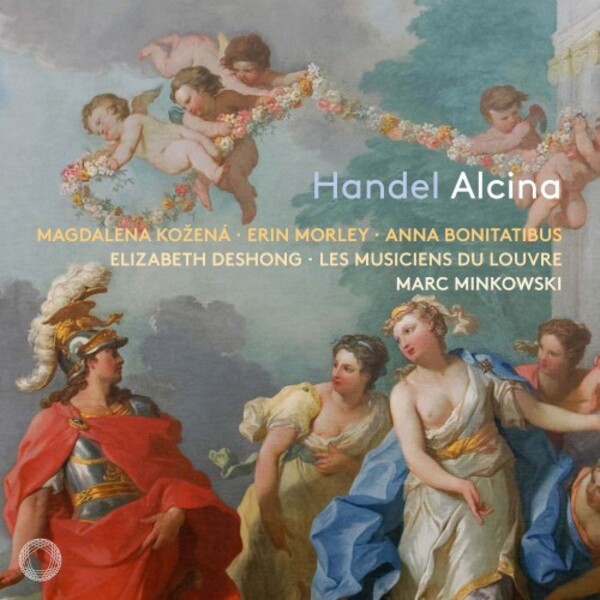HANDEL Alcina (Minkowski)
View record and artist detailsRecord and Artist Details
Label: Pentatone
Magazine Review Date: 04/2024
Media Format: CD or Download
Media Runtime: 182
Mastering:
DDD
Catalogue Number: PTC5187 084

Tracks:
| Composition | Artist Credit |
|---|---|
| Alcina |
George Frideric Handel, Composer
(Les) Musiciens du Louvre Alex Rosen, Melisso, Bass Alois Mühlbacher, Oberto, Countertenor Anna Bonitatibus, Ruggiero, Mezzo soprano Elizabeth Deshong, Bradamante, Mezzo soprano Erin Morley, Morgana, Soprano Magdalena Kozená, Alcina, Mezzo soprano Marc Minkowski, Conductor Valerio Contaldo, Oronte, Tenor |
Author: Richard Lawrence
Alcina was first staged on April 16, 1735, at John Rich’s new theatre at Covent Garden, where it ran for 18 performances. Like its predecessor, Ariodante, it was based on Orlando furioso, the epic poem by Ariosto. All the members of the cast but one had sung in Ariodante three months earlier, the exception being the boy who took the part of Oberto. Handel again took advantage of the availability of a small chorus and the presence of the French dancer Marie Sallé and her company.
As so often in Baroque opera, what looks complicated on paper is reasonably easy to follow on stage (but see below). Alcina is a sorceress who entices heroes to her island, where she seduces them before transforming them into wild beasts or inanimate things such as stones. She has fallen in love with the latest, Ruggiero: he, equally besotted, has forgotten Bradamante, his betrothed, who arrives, disguised as her brother, to rescue him.
Alcina has done well on record, with excellent versions including two conducted respectively by Richard Hickox and William Christie. Its popularity today stems from productions starring Joan Sutherland, who also recorded it (but not with period instruments). Magdalena KoŽená is the latest in a distinguished line, and she is absolutely terrific. Over the course of six arias Alcina expresses a range of emotions, which KoŽená conveys with brilliance and sensitivity. In ‘Di, cor mio’ she is almost kittenish, while stabbing violins and violas and a staccato bass line anticipate her anguished cries of ‘Perché?’ (‘Why?’) in ‘Ah, mio cor!’, a word that recurs in ‘Ombre pallide’. The despair of the latter aria is even more intense in the preceding accompagnato, where the shifting tonalities and the strange phrases in unison with unaccompanied violins indicate a disordered mind. In Alcina’s last aria, a siciliana in F sharp minor, Handel unexpectedly and sublimely moves to the tonic major for the B section. Here, as throughout, the shaping of KoŽená’s phrasing, her intensity and her care for the words are beyond praise.
Ruggiero, a castrato role, is well sung by Anna Bonitatibus. ‘Verdi prati’, where Ruggiero sadly contemplates the impending dissolution of the beautiful surroundings, is all the more effective for the simplicity of her delivery. ‘Sta nell’Ircana’ is exciting, but here she is outclassed by Della Jones on the Hickox recording: some of the best Handel singing you will hear anywhere, abetted by a pair of properly prominent high horns. As Bradamante, who is reunited with Ruggiero by the end, Elizabeth DeShong is spirited in ‘È gelosia’ and wrathful in ‘Vorrei vendicarmi’: two D major arias taken very fast, with spot-on chains of semiquavers. Bradamante’s gentler side comes out in ‘All’alma fedel’, DeShong spinning a long, flowing line.
Morgana, Alcina’s hapless sister, who falls in love with the disguised Bradamante, gives Oronte a hard time and ends up with no one, has three arias. Two feature a solo instrument, respectively a violin and a cello: Alice Piérot introduces unexaggerated rubato to ‘Ama, sospira’, while Gauthier Broutin brings a Bachian sensibility to ‘Credete al mio dolore’. Handel also gives Morgana the plum that concludes the first act, ‘Tornami a vagheggiar’: I particularly liked the way Erin Morley alternates staccato and legato on the prolonged last syllable of ‘vagheggiar’. There are fine contributions, too, from Valerio Contaldo and Alex Rosen. The countertenor Alois Mühlbacher sings sweetly as the boy Oberto, a part he took as a treble on the Minkowski DVD (ArtHaus Musik, 12/11), though I did wonder why it was necessary to transpose two of his three arias down a tone.
Under Marc Minkowski’s inspired direction the orchestra is fully part of the drama: just listen to the violence of the repeated quavers at the beginning of Alcina’s accompagnato ‘Ah! Ruggiero crudel’. The version is that of 1735, played complete with just a few repeats omitted in the dances. There are no trumpets in the score: the names in the booklet presumably belong to the unmentioned horn players. And, as hinted above, there is no synopsis. But this is an excellent set that will give much pleasure.
Explore the world’s largest classical music catalogue on Apple Music Classical.
Included with an Apple Music subscription. Download now.

Gramophone Digital Club
- Digital Edition
- Digital Archive
- Reviews Database
- Events & Offers
From £9.20 / month
Subscribe
Gramophone Club
- Print Edition
- Digital Edition
- Digital Archive
- Reviews Database
- Events & Offers
From £11.45 / month
Subscribe
If you are a library, university or other organisation that would be interested in an institutional subscription to Gramophone please click here for further information.






